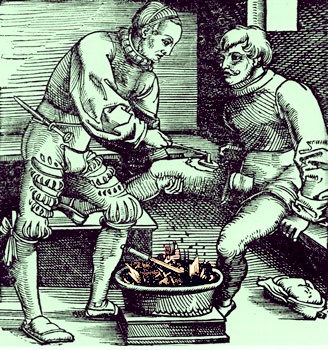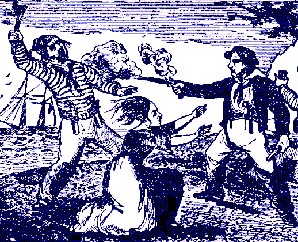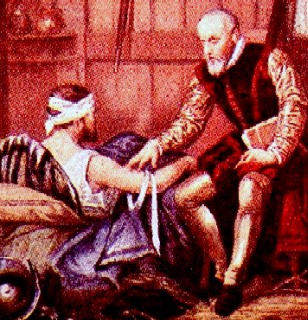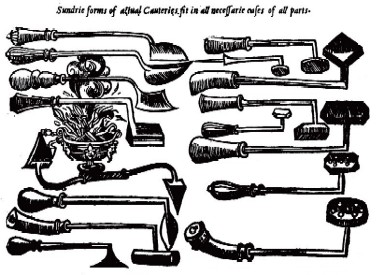
Cauterizing Procedure Page Menu: 1 2 3 4 5 6 7 8 Next>>
Cauterizing Procedure During the Golden Age of Piracy, Page 1
"[Pirate captain John Phillips crew] There was no Surgeon aboard, and therefore it was advis'd, upon a learned Consultation, that Phillips's Leg should be cut off; but who should perform the Operation was the Dispute, at length the Carpenter [Thomas Fern] was appointed, as the most proper Man. Upon which, he fetch'd up the biggest Saw, and taking the Limb under his Arm, fell to Work, and separated it from the Body of the Patient, in as little Time as he could have cut a Deal Board in two, after that he heated his Ax red hot in the Fire, and cauteriz'd the Wound, but not
with so much Art as he performed the other

Cauterizing, From Albucasis Chirurgicorum Omnium Primarii (1532)
Part, for he so burnt his Flesh distant from the Place of Amputation, that it had like to have mortify'd [turned gangrenous], however nature performed a Cure at last without any other Assistance." (Johnson, 3rd, p. 400-1)
In medicine, cauterizing is the practice of burning the flesh for surgical reasons - often to stop bleeding or other fluids, to remove unwanted skin or to create an entry point into the skin. Although it was a procedure still in practice during the golden age of piracy, it had been declining in popularity among surgeons for almost a century. Certain surgeons such as Richard Wiseman still swore by the practice, but many others were replacing it with less drastic methods such as medicines and ligatures where they could also serve. (There is an interesting comparison of the various procedures used to stop blood loss in the article on amputation.) Even so, the procedure is discussed by nearly all of the sea surgeons writing during this time so it is relevant to surgery during the golden age of pirates.
This article begins with a (very brief) overview of the history of the cautery in medicine. It focuses primarily on period and near-period accounts of cauterization, using them to examine the pros and cons of cautery use in surgery, which procedures used cauterization and how potential (chemical and oil-based) and actual (cautery iron-based) cauterizing procedures were performed.
The History of Cauterizing in Medicine
Cauterizing

Hippocrates
as a surgical technique probably dates back to shortly after the discovery of fire. In print, however, it first appears in the Hippocrates around the 4th century BC. He used it to treat hemorrhoids, advising his readers to "make the irons red-hot, and burn the pile until it be dried up, and so as that no part may be left behind. And burn so as to leave none of the hemorrhoids unburnt, for you should burn them all up."1 Hippocrates also suggests cautery use when opening abscesses, done "either by incision or actual cautery"2, to open fluid build-up under the skins called dropsies3 and in treating sciaticas where the bone has come out of its socket4.

Artist: P R Vigneron - Aulus Cornelius Celsus
As frequently happened with Hippocratic writings, future classical authors incorporated his ideas into their works and expanded greatly upon them. The most significant example of this with regard to cauterizing is from the writings of Aulus Cornelius Celsus. He significantly advised their use in eliminating gangrene, noting that "the place should be burnt by a cautery until no more humour escapes from it; for sound flesh is dry when it is burnt."5 He also added the use of burning to the treatments of mad dog bites6, fistulas7, removal of improperly grown eyelashes8, fixing drooping eyes9, preventing discharges from the eye10, blood- and pus-exuding ulcers11 and even featured a cauterizing knife in abscess treatment12.
Expansion of cauterization

Albucasis - Abu al-Qasim al-Zahrawi
was continued by Arabic practitioners in the 10th and 11th centuries. At this time, much of the advances in surgery were occurring in the Arabic world. "The Arabs used cauteries for the treatment of bleeding wounds and ulcers, the obliteration of inguinal hernias [a protrusion of the abdominal cavity contents through the inguinal canal], and the debulking of tumors [removing part a malignant tumor]."13 The renowned Andalusian surgeon Albucasis [Abu al-Qasim al-Zahrawi] even suggested them as a way to treat round worms under the skin14, something we will look at in greater detail later.
Cauterization was further pushed into main stream European medicine around this time by Pope Alexander III's edict from the Council of Tours in 1163, which stated, "The church abhors bloodletting."15 As a result, it became a way for the priests and monks who served as the surgeons during that time to perform operations "since it did not violate the ecclesiastical prohibition of shedding blood."16
Of course, much of the on-going interest in cauterization was because Hippocrates and Celsus had relied upon it. They were were two of the most revered "classical" authors upon whom much of the prevailing golden age of piracy medical theory was based. Their ideas continued to have relevance throughout much of medicine's history. European medical texts of the 12th -19th century continued to advance their ideas.

Charles Gibbs Shooting a Comrade, From The Pirates
Own Book by Charles Ellms (1837)
Cauterization came to the fore once again with the advent of gunshot wounds. For many, medical theory in the 15th - 17th centuries held that anything that needed to be known about medical practices had already been covered by the ancients. However, gunshot wounds presented something of a conundrum for the physicians and surgeons of that era. Gunshot wounds were something that couldn't have been covered by the ancients, because couldn't advise proper treatment for something they had never encountered.
German surgeon Hieronymous Brunscwig, one of the first medical authors to take on this new medical problem, advanced the idea that gunshot wounds were poisoned. In his 1497 book Das buch der cirurgia: hantwirckung der wundartzny, "he promoted the doctrine originally proposed by Pfolspendt [Heinrich von Pfolsprundt in his 1460 Buch der Bündth-Ertznei] that such wounds were poisoned by gunpowder. That theory provided the rationale for cauterizing all war wounds and initiated a controversy that persisted for 300 years."17 Although the argument over the poisoning of gunshot wounds may have continued for 300 years, cautery was one of the classical operations that lost favor early on, thanks largely to its use in gunshot wound treatment.

Artist: E Hammon, Pare dressing a Soldier/Patient_
Ambroise Paré was treating soldiers wounded by gunshot, following the advice of physician John de Vigo [Giovanni da Vigo, a 15th/16th century Italian
surgeon] from his book Of Wounds in General. In the middle of his treatments, Paré ran out of the boiling oil he was using to cauterize the wounds.
Paré explains that he "was constrained in steed thereof, to apply a digestive [substance to promote healthy flesh formation in a wound] of yolkes of egges, oyle of Roses, and Turpentine."18 Fearing it would not work, he returned early the next morning "where beyond my expectation I found those to whom I had applied my digestive medicine, to feele little paine, and their wounds without inflammation or tumor, having rested reasonable well in the night: the others to whom was used the sayd burning oyle, I found them feverish, with great paine and tumour about the edges of their wounds. And then I resolved with my selfe never so cruelly, to burne poore men wounded with gunshot."19 [For more detail, see the article on Bullet Extraction.]
Paré believed in practicing medicine based on his own experience rather than relying exclusively on the advice of the ancient surgeons and physicians. He was also the first to recommend ligatures [silk strands] to stop arterial bleeding when amputating. Although cauteries continued to be used throughout the golden age of piracy, Paré's publication of such discoveries led other surgeons to consider abandoning the painful and often difficult to administer cauteries in favor of more humane methods.
1 Hippocrates, Hippocratic Writings, Translated and Edited by Francis Adams, p. 151; 2 Hippocrates & Lucas Verhoofd, The Aphorisms of Hippocrates, p. 151; 3 Hippocrates, Aphorisms, p. 131; 4 Hippocrates, Aphorisms, p. 139; 5 A. Cornelius Celsus, De Medicina, Volume II, Loeb Classical Library Edition, p. 104-5; 6 Celsus, Vol. II, p. 113;7 Celsus, Vol. VII, p. 337; 8 Celsus, Vol. VII, p. 339; 9 Celsus, Vol. VII, p. 345; 10 Celsus, Vol. VII, p. 355; 11 Celsus, Vol. VII, p. 359; 12 A. Cornelius Celsus, De Medicina, Volume VII, Loeb Classical Library Edition, p. 301; 13 Basil A. Pruitt, Jr., "Combat Casualty Care and Surgical Progress," Annals of Surgery, Vol. 243, Number 6, June 2006. p. 716; 14 M.S. Spink and G.L. Lewis, Albucasis On Surgery and Instruments; A Definitive Edition of the Arabic Text with English Translation and Commentary, p. 604; 15 Gilbert R. Seigworth, "A Brief History of Bloodletting: Bloodletting Over the Centuries", Gilbert R. Seigworth, M.D.PBS.org, gathered 8/24/14; 16, 17 Pruitt, ibid.; 18 Ambroise Paré, The Apologie and Treatise of Ambroise Paré, p. 23; 19 Paré, p. 23-4
Cauterizing Agents
Before

Cautery Irons, Set 1, from The Workes of That Famous Chirurgeon
Ambrose Parey, p. 485 (1649)
we delve into the intricacies of the cauterizing procedure during the golden age of piracy, the two basic types of cautery agents must be defined.
The first are cautery irons, which are iron rods with formed metal head and wooden handles. These were often referred to during this period as "actual cauteries." They were heated in a brazier of coals, also called a chafing dish, which was usually kept close at hand during surgeries for immediate use. The size, type and variety of these cautery irons is quite extensive because the design of the cautery iron had to match the purpose for which the surgeon intended it. A full discussion of the various sizes, types and uses of cautery irons can be found in the Cauterizing Tools article.
The second type of cauterizing agents were chemical in nature and were often referred to during this time as "potential cauteries." They were recognized as being less painful and damaging than actual cauteries, causing some surgeons to recommend them over actual cauteries during the golden age of piracy. Types of potential cauteries included arsenic, boiling oil, moxa, various sulfates such as sulfuric acid and some mercury compounds. A detailed discussion of various potential cauterizing agents can be found in the Cauterizing Tools article.

